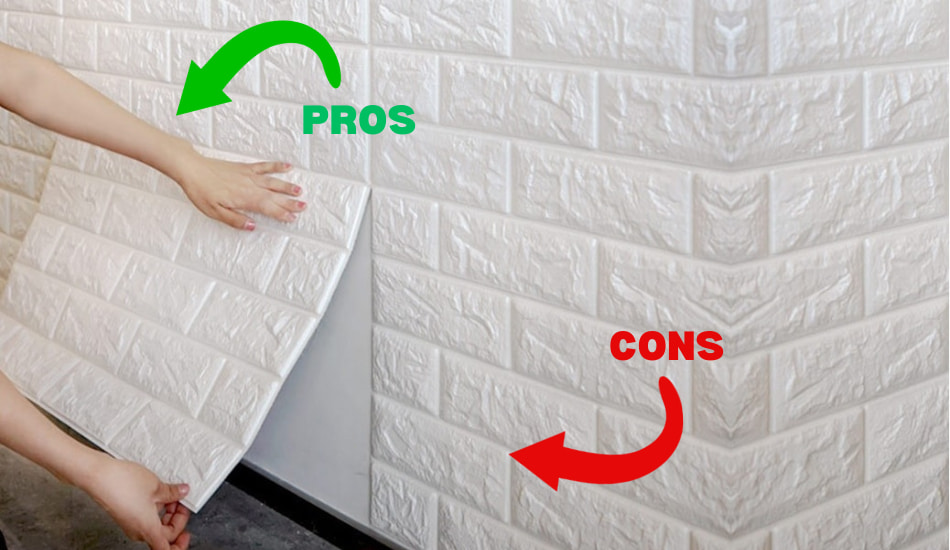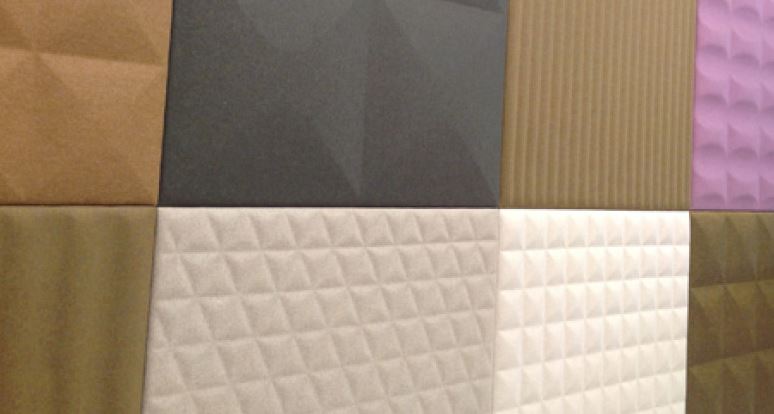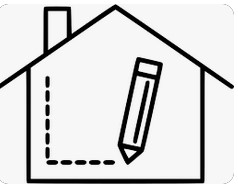Pros and Cons of Soundproof Wallpaper

Soundproof wallpaper has gained popularity as an easy-to-install, aesthetically pleasing option for managing acoustics within a room. However, like everything, it comes with its own set of advantages and drawbacks. Let’s get into the pros and cons of using soundproof wallpaper to understand if it’s the right choice for your specific needs.
If you have decided to renovate the room, a frequently proposed solution is soundproof wallpaper, which might have piqued your interest during your online research. However, the real worth of a product can only be determined by fully understanding its pros and cons. So, let’s start!
What Actually Is Soundproof Wallpaper?

It’s important to understand what soundproof wallpaper actually is before we start with its pros and cons. As the name suggests, it’s a type of wallpaper that is designed to block the sound. But what makes it different?
Unlike conventional wallpaper, which consists of a single substantial layer of printed paper, soundproof wallpaper is constructed with multiple layers of different materials.
> Buy Soundproof Wallpaper HERE <
A key component in these layers is often acoustic foam (in some cases, material very similar to it). If you’re familiar with the field of soundproofing, it’s common knowledge that the role of acoustic foam is not specifically to block the noise.
So Can You Reduce Noise By Using A Soundproof Wallpaper?
No, you cant! Soundproof wallpaper significantly influences the acoustics within a room (which is similar to the role of acoustic foam), acting as an effective echo controller, but it does not give good results.
However, it is not its primary function. In short, while soundproof wallpaper doesn’t entirely eliminate noise, it can be a more visually attractive alternative to acoustic foam.
The Pros and Cons Of Soundproof Wallpaper
After we get acquainted with the basics of soundproof wallpaper and what it is used for, it will be easier for us to understand its advantages and disadvantages. To delve deeper into the specificities of soundproof wallpaper, let’s explore its pros and cons.
Here is a short list table of its pros and cons:
| The Pros | The Cons |
|---|---|
| 1. Very Cheap | 1. Lacks Soundproofing Capabilities |
| 2. Installation is Simple | 2. Not Highly Effective When Used Alone |
| 3. A Wide Variety of Designs Is Available | 3. Lacks Significant Durability |
| 4. Manages the Acoustics of the Room | 4. Not Ideally Suited for a Variety of Rooms |
| 5. Resistant to Fire | 5. There Are Better Alternatives |
The Pros
1. Very Cheap

Even though soundproof wallpaper may cost a bit more than normal wallpaper, it is still a much cheaper option when compared to other wall soundproofing materials (for example mass loaded vinyl or drywall).
How much money you have at your disposal mainly affects the approach to soundproofing projects. Fortunately, soundproof wallpaper is, without a doubt more affordable alternative. This proves particularly beneficial when dealing with larger walls, as the cost of wallpapering an entire room is still cheap.
Yet, like with any purchase, the price will depend on the quality of the wallpaper. Opting for the cheapest options may not yield satisfactory results for your space.
2. Installation is Simple

Usually, most soundproofing methods can prove to be quite a challenge when it comes to actual installation. Take, for instance, soundproofing a stud wall, which at the very least, requires removing the wall completely.
However, installing soundproof wallpaper is as easy as applying regular wallpaper. Having always enjoyed home decor, I found it quite simple to learn the wallpaper installation process.
If you were to compare it with mass-loaded vinyl, installing wallpaper is definitely much easier. The process essentially involves applying the paste on its back and adhering it to the wall. The trickiest aspects are ensuring it’s straight and aligning the patterns correctly. But overall, it’s a rather uncomplicated task.
Nonetheless, like all projects, it’s worth planning ahead. You should at least calculate the room’s area to determine the amount of wallpaper needed. The whole process should take an hour to two hours, which is quite a bit compared to other methods.
3. A Wide Variety of Designs Is Available

The soundproof wallpaper industry is continuously expanding, offering a large selection of models you can find on the market. Therefore, you will have a large selection that can be adapted to any room.
One of the significant disadvantages when it comes to classic soundproofing materials is their aesthetic appeal. Most of them are designed to be concealed, prioritizing functionality over aesthetics.
When you consider materials like MLV that are used for soundproofing, your choice is not very big. Although aesthetics might seem like a minor concern when it comes to soundproofing a space, you wouldn’t want a lot to change in the room you live in.
In this regard, soundproof wallpaper is an ideal final touch to your space, effectively balancing style and practicality.
4. Manages the Acoustics of the Room

I’ve pointed this out before: soundproof wallpaper doesn’t genuinely soundproof. Its role is more akin to that of acoustic foam, which ameliorates the acoustics within a room. In other words, they reduce echo and sound amplification.
How much the soundproof wallpaper will reduce the sound depends on the specific acoustic issue and the products quality you’re trying to address. If you discover that despite your soundproofing efforts, there are still problems, try and use soundproof wallpaper as the solution.
Additionally, soundproof wallpaper is a much better choice than acoustic foam as you can avoid the trouble of locating echo points in the space or devising ways to conceal the foam.
However, if dealing with acoustics is a major concern in your space, you might still want to consider acoustic foam. Its usual thickness and shape make it more effective at controlling sound waves.
These sound waves have a tendency to bounce off, so the goal is to minimize these. Despite its benefits, soundproof wallpaper remains a flat surface.
5. Resistant to Fire

Although fire safety is not the first thing you think of when planning to soundproof a room, it is also good to keep that in mind. This becomes even more crucial if you’re soundproofing areas like a main room or a recording studio laden with electrical gadgets.
In some cases, soundproof wallpapers comply with the necessary fire safety norms. The materials utilized in their construction are typically fire-resistant, which means that the wallpaper would not contribute to the spread of a fire, should one occur.
Although it’s unlikely your soundproofing plan revolves around fire safety, if you’re exploring solutions that enhance your room’s fire resistance, soundproof wallpaper would definitely make a viable choice.
Related Article: What Is The Best Material That Absorbs Sound?
The Cons
1. Lacks Soundproofing Capabilities
Soundproof wallpaper does not have actual soundproofing capabilities. True soundproofing materials are much thicker, and they require mass to prevent noise transmission between spaces.
To soundproof a wall effectively, you require materials that absorb vibration, a common source of noise pollution. However, soundproof wallpaper lacks these essential elements.
Furthermore, it’s important to note that even the thickest soundproof wallpaper options available can barely enhance a room’s soundproofing efficacy, similar to soundproof paint. Nonetheless, soundproof wallpaper isn’t entirely useless.
It could be a good option if you aim to manage room acoustics, but it’s crucial to understand that it won’t serve as a sound barrier, as it’s not designed for that purpose.
2. Not Highly Effective When Used Alone
While this is not a downside of soundproof wallpaper, it’s important to note that it typically doesn’t perform very well when used alone (without the combination of other materials). Therefore, it should ideally be a part of a more comprehensive set of soundproofing strategies.
So, if you want to soundproof the room, you need to add some other material in combination with soundproof wallpaper. Likewise, addressing vibration issues, which are not tackled by soundproof wallpaper, would be beneficial.
To maximize the effectiveness of a soundproof wallpaper, consider incorporating a layer of MLV beneath it. This additional layer will effectively reduce sound waves in the room, while the wallpaper will assist in managing the room’s acoustics.
3. Lacks Significant Durability
The debate over wallpaper’s longevity and soundproof paint is a long-standing one in the term of DIY, and it seems unlikely to end anytime soon. From my perspective, I’ve noticed that wallpaper isn’t an especially long-lasting solution for wall coverings.
While this article covers soundproof wallpaper, it’s important to mention its durability. After all, when you’re refurbishing a room, you’re aiming for a look that will last for a long time.
The endurance of soundproof wallpaper is dependent on its quality. It’s essential not to overlook any edges as they are the initial spots that begin to peel.
Moreover, if you have children, wallpaper might not be your best choice. Paint, in my experience, is simpler to clean should the kids decide to express their creativity on the walls. Plus, paint can be touched up if it gets stained beyond cleaning, while wallpaper requires removal and replacement to get rid of a mark.
I suggest alternative options if you’re pondering soundproof wallpaper primarily for aesthetic reasons rather than its functional aspects. Its contribution to the room’s sound management is minimal, and given that cleaning wallpaper isn’t really feasible, there are likely better choices available.
4. Not Ideally Suited for a Variety of Rooms
This point pertains more to the general use of wallpaper, but it’s still relevant when discussing soundproof wallpaper. Despite claims by some manufacturers that some soundproof wallpapers are water resistant, you have to be skeptical sometimes.
Since the adhesive used for wallpaper is water-based, it’s not suitable for rooms prone to high levels of humidity or steam. While you may not typically think of soundproofing spaces like your kitchen or bathroom, it could be a consideration for your basement.
Wallpaper exposed to damp conditions over an extended period tends to peel as the adhesive loses its bonding strength, which could happen quicker than you might anticipate. This is not a concern with materials like MLV, as they’re secured with nails.
Basements often make a great space for soundproofing projects, given their typically open, adaptable layout, making it easier to implement structural modifications. However, basements also tend to be humid spaces, so it’s recommended to steer clear of soundproof wallpaper in such scenarios.
5. There Are Better Alternatives
Soundproof wallpaper may initially seem like an appealing option, but it’s important to note that there are several alternative solutions that often prove to be more effective. These solutions are: Acoustic Foam Panels, Mass Loaded Vinyl (MLV), Drywall or Soundproofing Drywall, Weatherstripping and more.
Remember, a combination of these methods is often the best approach to effectively soundproof a room. Also, it’s important to consider the specific source of the noise and the layout of your room before deciding which solution(s) to implement.
If you want to learn more about this topic, be sure to check this video:
Related article: Are Moving Blankets Soundproof? (Explained)
Final thoughts
Lastly, soundproof wallpaper comes with its own set of pros and cons as we could see in this article. However, in my opinion, the disadvantages take the lead due to practicality concerns, specifically regarding the application process and the longevity of its usefulness.
Therefore, I suggest you explore the best soundproofing methods and only choose soundproof wallpaper as a complementary finishing touch.
While it can indeed serve a purpose in some soundproofing tasks, it shouldn’t be your primary choice. There are numerous superior products out there that give better results than this one.
